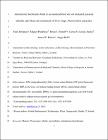| dc.contributor.author | BELL, ANGUS | |
| dc.contributor.author | DEMPSEY, ENDA | |
| dc.date.accessioned | 2013-07-08T15:15:46Z | |
| dc.date.available | 2013-07-08T15:15:46Z | |
| dc.date.issued | 2013 | |
| dc.date.submitted | 2013 | en |
| dc.identifier.citation | Dempsey E, Prudencio M, Fennell BJ, Gomes-Santos CS, Barlow JW & Bell A, Antimitotic herbicides bind to an unidentifed site on malarial parasite tubulin and block development of liver-stage Plasmodium parasites., Molecular & Biochemical Parasitology, 188, 2013, 116 - 127 | en |
| dc.identifier.other | Y | |
| dc.identifier.uri | http://hdl.handle.net/2262/66648 | |
| dc.description | PUBLISHED | en |
| dc.description.abstract | Malarial parasites are exquisitely susceptible to a number of microtubule inhibitors but most of these compounds also affect human microtubules. Herbicides of the dinitroaniline and phosphorothioamidate classes however affect some plant and protozoal cells but not mammalian ones. We have previously shown that these herbicides block schizogony in erythrocytic parasites of the most lethal human malaria, Plasmodium falciparum, disrupt their mitotic spindles, and bind selectively to parasite tubulin. Here we show for the first time that the antimitotic herbicides also block the development of malarial parasites in the liver stage. Structure-based design of novel antimalarial agents binding to tubulin at the herbicide site, which presumably exists on (some) parasite and plant tubulins but not mammalian ones, can therefore constitute an important transmission blocking approach. The nature of this binding site is controversial, with three overlapping but non-identical locations on ?-tubulin proposed in the literature. We tested the validity of the three sites by (i) using site-directed mutagenesis to introduce six amino acid changes designed to occlude them, (ii) producing the resulting tubulins recombinantly in Escherichia coli and (iii) measuring the affinity of the herbicides amiprophosmethyl and oryzalin for these proteins in comparison with wild-type tubulins by fluorescence quenching. The changes had little or no effect, with dissociation constants (Kd) no more than 1.3-fold (amiprophosmethyl) or 1.6-fold (oryzalin) higher than wild-type. We conclude that the herbicides impair Plasmodium liver stage as well as blood stage development but that the location of their binding site on malarial parasite tubulin remains to be proven. | en |
| dc.description.sponsorship | This work was supported by grants from the Enterprise Ireland Commercialisation Fund (no. PC/2005/0700) to AB and JW, the Irish Research Council for Science, Engineering and Technology to BJF and AB, Science Foundation Ireland (no. 08/BMT/1062) to AB, and Fundac?o para a Ciencia e Tecnologia, Portugal (nos. PTDC/SAU-MII/099118/2008 and PTDC/SAU-MIC/117060/2010) to MP. | en |
| dc.format.extent | 116 | en |
| dc.format.extent | 127 | en |
| dc.language.iso | en | en |
| dc.relation.ispartofseries | Molecular & Biochemical Parasitology; | |
| dc.relation.ispartofseries | 188; | |
| dc.rights | Y | en |
| dc.subject | Malaria; Plasmodium; Tubulin; Microtubules; Antimalarial chemotherapy | en |
| dc.subject.lcsh | Malaria; Plasmodium; Tubulin; Microtubules; Antimalarial chemotherapy | en |
| dc.title | Antimitotic herbicides bind to an unidentifed site on malarial parasite tubulin and block development of liver-stage Plasmodium parasites. | en |
| dc.type | Journal Article | en |
| dc.type.supercollection | scholarly_publications | en |
| dc.type.supercollection | refereed_publications | en |
| dc.identifier.peoplefinderurl | http://people.tcd.ie/abell | |
| dc.identifier.peoplefinderurl | http://people.tcd.ie/dempseen | |
| dc.identifier.rssinternalid | 84551 | |
| dc.identifier.rssuri | http://authors.elsevier.com/sd/article/S0166685113000340 | en |
| dc.contributor.sponsor | Enterprise Ireland | en |
| dc.contributor.sponsorGrantNumber | PC/2005/0700 | en |
| dc.contributor.sponsor | Science Foundation Ireland (SFI) | en |
| dc.contributor.sponsorGrantNumber | 08/BMT/1062 | en |















